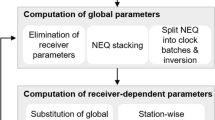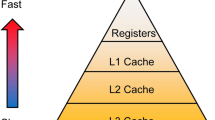Abstract
Global navigation satellite systems (GNSS) are acting as an indispensable tool for geodetic research and global monitoring of the Earth, and they have been rapidly developed over the past few years with abundant GNSS networks, modern constellations, and significant improvement in mathematic models of data processing. However, due to the increasing number of satellites and stations, the computational efficiency becomes a key issue and it could hamper the further development of GNSS applications. In this contribution, this problem is overcome from the aspects of both dense linear algebra algorithms and GNSS processing strategy. First, in order to fully explore the power of modern microprocessors, the square root information filter solution based on the blocked QR factorization employing as many matrix–matrix operations as possible is introduced. In addition, the algorithm complexity of GNSS data processing is further decreased by centralizing the carrier-phase observations and ambiguity parameters, as well as performing the real-time ambiguity resolution and elimination. Based on the QR factorization of the simulated matrix, we can conclude that compared to unblocked QR factorization, the blocked QR factorization can greatly improve processing efficiency with a magnitude of nearly two orders on a personal computer with four 3.30 GHz cores. Then, with 82 globally distributed stations, the processing efficiency is further validated in multi-GNSS (GPS/BDS/Galileo) satellite clock estimation. The results suggest that it will take about 31.38 s per epoch for the unblocked method. While, without any loss of accuracy, it only takes 0.50 and 0.31 s for our new algorithm per epoch for float and fixed clock solutions, respectively.









Similar content being viewed by others
References
Bierman GJ (1975) The treatment of bias in the square-root information filter/smoother. J Optim Theory Appl 16(1):165–178. https://doi.org/10.1007/BF00935630
Bischof C, Van Loan C (1987) The WY representation for products of Householder matrices. SIAM J Sci Stat Comput 8(1):2–13. https://doi.org/10.1137/0908009
Blewitt G (2008) Fixed point theorems of GPS carrier phase ambiguity resolution and their application to massive network processing: Ambizap. J Geophs Res 113(B12410):36–44. https://doi.org/10.1029/2008JB005736
Blewitt G, Bertiger W, Weiss JP (2010) Ambizap3 and GPS carrier-range: a new data type with IGS applications. In: Proceedings of IGS workshop and vertical rates, Newcastle
Brockmann E, Gurtner W (1996) Combination of GPS solutions for densification of the European network. In: International Association of Geodesy, Section 1, Publication No. 5 report on the symposium of the IAG Subcommission for Europe (EUREF) Held in Ankara
Chen H, Jiang WP, Ge MR, Wickert J, Schuh H (2014) An enhanced strategy for GNSS data processing of massive networks. J Geod 88(9):857–867. https://doi.org/10.1007/s00190-014-0727-7
Demmel JW (1997) Applied numerical linear algebra. SIAM, Philadelphia
Dongarra J, Du Croz J, Duff I, Hammarling S, Duff I (1988) A set of level 3 basic linear algebra subprograms. ACM Trangs Math Softw 16(1):1–17. https://doi.org/10.1145/77626.79170
Donfack S, Dongarra J, Faverge M, Gates M, Kurzak J, Luszczek P, Yamazaki I (2013). On algorithmic variants of parallel Gaussian elimination: comparison of implementations in terms of performance and numerical properties. Technical report, Innovative Computing Laboratory, University of Tennessee
Ge M, Gendt G, Dick G, Zhang F, Rothacher M (2006) A new data processing strategy for huge GNSS global networks. J Geod 80(4):199–203. https://doi.org/10.1007/s00190-006-0044-x
Ge M, Gendt G, Rothacher M, Shi C, Liu J (2008) Resolution of GPS carrier-phase ambiguities in precise point positioning (PPP) with daily observations. J Geod 82(7):389–399. https://doi.org/10.1007/s00190-007-0187-4
Ge M, Chen J, Dousa J, Gendt G, Wickert J (2012) A computationally efficient approach for estimating high-rate satellite clock corrections in realtime. GPS Solut 16(1):9–17. https://doi.org/10.1007/s10291-011-0206-z
Geng J, Shi C, Ge M, Dodson A, Lou Y, Zhao Q, Liu J (2012) Improving the estimation of fractional-cycle biases for ambiguity resolution in precise point positioning. J Geod 86(8):579–589. https://doi.org/10.1007/s00190-011-0537-0
Gunnels JA (2001) A systematic approach to the design and analysis of linear algebra algorithms. Ph.D. thesis, Department of Computer Sciences, The University of Texas
Gu S, Shi C, Lou Y, Feng Y, Ge M (2013) Generalized-positioning for mixed-frequency of mixed-GNSS and its preliminary applications. In: Proceedings on China satellite navigation conference (CSNC), pp 399–428. https://doi.org/10.1007/978-3-642-37404-3_35
Gu S, Shi C, Lou Y, Liu J (2015a) Ionospheric effects in uncalibrated phase delay estimation and ambiguity-fixed PPP based on raw observable model. J Geod 89(5):447–457. https://doi.org/10.1007/s00190-015-0789-1
Gu S, Lou Y, Shi C, Liu J (2015b) BeiDou phase bias estimation and its application in precise point positioning with triple-frequency observable. J Geod 89(10):979–992. https://doi.org/10.1007/s00190-015-0827-z
Hammarling S, Lucas C (2008) Updating the QR factorization and the least squares problem. The University of Manchester
Hatch R (1982) The synergism of GPS code and carrier measurements. In: Proceedings of the third international symposium on satellite Doppler Positioning at Physical Sciences Laboratory of New Mexico State University, Feb. 8–12, vol 2, pp 1213–1231
Ling F, Manolakis D, Proakis J (1986) A recursive modified Gram-Schmidt algorithm for least- squares estimation. IEEE Trans Acoust Speech Signal Process 34(4):829–836. https://doi.org/10.1109/TASSP.1986.1164877
Lou Y, Gong X, Gu S, Zheng F, Feng Y (2017) Assessment of code bias variations of BDS triple-frequency signals and their impacts on ambiguity resolution for long baselines. GPS Solut 21(1):177–186. https://doi.org/10.1007/s10291-016-0514-4
Low T, van de Geijn R (2004) An API for manipulating matrices stored by blocks. FLAME Working Note #12 TR-2004-15, The University of Texas at Austin, Department of Computer Sciences
Melbourne WG (1985) The case for ranging in GPS-based geodetic systems. In: Proceedings of first international symposium on precise positioning with the global positioning system, Rockville, pp 373–386
Montenbruck O, Steigenberger P, Khachikyan R, Weber G, Langley RB, Mervart L, Hugentobler U (2014) IGS-MGEX: preparing the ground for multi-constellation GNSS science. Inside GNSS 9(1):42–49
Montenbruck O, Steigenberger P, Prange L, Deng Z, Zhao Q, Perosanz F et al (2017) The multi-GNSS experiment (MGEX) of the international GNSS service (IGS)—achievements, prospects and challenges. Adv Space Res 59(7):1671–1697. https://doi.org/10.1016/j.asr.2017.01.011
Puglisi C (1992) Modification of the householder method based on the compact WY representation. SIAM J Sci Stat Comput 13(3):723–726. https://doi.org/10.1137/0913042
Quintana-Ort G, Quintana-Ort E, Chan E, Zee F, Geijn R (2007) Scheduling of QR factorization algorithms on SMP and multi-core architectures FLAME working note #24. In: 16th Euromicro conference on parallel, distributed and network-based processing. IEEE Computer Society, pp 301–310
Quintana-Ortí G, Sun X, Bischof CH (1998) A BLAS-3 version of the QR factorization with column pivoting. SIAM J Sci Comput 19(5):1486–1494. https://doi.org/10.1137/S1064827595296732
Rao C (1973) Linear statistical inference and its applications. Wiley, New York
Reichel L, Gragg WB (1990) Algorithm 686: FORTRAN subroutines for updating the QR decomposition. ACM Trans Math Softw 16(4):369–377. https://doi.org/10.1145/98267.98291
Schreiber R, Van Loan C (1989) A storage-efficient WY representation for products of householder transformations. SIAM J Sci Stat Comput 10(1):53–57. https://doi.org/10.1137/0910005
Teunissen P (1995) The least-squares ambiguity decorrelation adjustment a method for fast GPS integer ambiguity estimation. J Geod 72(10):606–612. https://doi.org/10.1007/BF00863419
Uhlemann M, Gendt G, Ramatschi M, Deng Z (2015) GFZ global multi-GNSS network and data processing results. In: IAG 150 years. International Association of Geodesy Symposia, vol 143. https://doi.org/10.1007/1345_2015_120
Wanninger L, Beer S (2015) BeiDou satellite-induced code pseudorange variations: diagnosis and therapy. GPS Solut 19(4):639–648. https://doi.org/10.1007/s10291-014-0423-3
Wübbena G (1985) Software developments for geodetic positioning with GPS using TI-4100 code and carrier measurements. In: Proceedings of first international symposium on precise positioning with the global positioning system, Rockville, pp 403–412
Acknowledgements
This study is partially supported by the National Key Research and Development Plan (No. 2016YFB0501802), the National Natural Science Foundation of China (41374034 and 41504028), and the Natural Science Foundation of Hubei (2015CFB326). And the thanks are also given to IGS and CMONOC for providing data.
Author information
Authors and Affiliations
Corresponding author
Appendix
Appendix
According to Eqs. (5) to (10) in Sect. 2.1, Tables 6 and 7 give the details of algorithm complexity of each step involved in filter and prediction, respectively. It is noted that we do not distinguish different operators (e.g., addition, subtraction, multiplication, division), in other words, they are all treated as one arithmetic operation in the following analysis. Here again, \(n=n_y +n_p \) is the number of parameters, m represents the number of observations plus parameters; \(r=\frac{n_y}{n_p}\) is the ratio of the parameter number of ambiguities to other unknowns.
Rights and permissions
About this article
Cite this article
Gong, X., Gu, S., Lou, Y. et al. An efficient solution of real-time data processing for multi-GNSS network. J Geod 92, 797–809 (2018). https://doi.org/10.1007/s00190-017-1095-x
Received:
Accepted:
Published:
Issue Date:
DOI: https://doi.org/10.1007/s00190-017-1095-x




